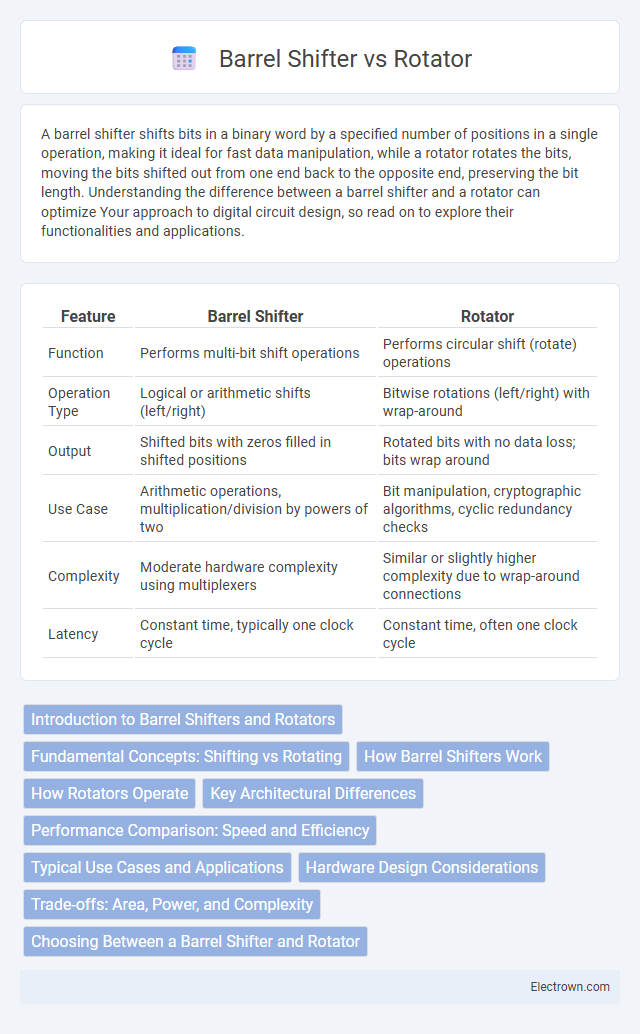A barrel shifter shifts bits in a binary word by a specified number of positions in a single operation, making it ideal for fast data manipulation, while a rotator rotates the bits, moving the bits shifted out from one end back to the opposite end, preserving the bit length. Understanding the difference between a barrel shifter and a rotator can optimize Your approach to digital circuit design, so read on to explore their functionalities and applications.
Table of Comparison
| Feature | Barrel Shifter | Rotator |
|---|---|---|
| Function | Performs multi-bit shift operations | Performs circular shift (rotate) operations |
| Operation Type | Logical or arithmetic shifts (left/right) | Bitwise rotations (left/right) with wrap-around |
| Output | Shifted bits with zeros filled in shifted positions | Rotated bits with no data loss; bits wrap around |
| Use Case | Arithmetic operations, multiplication/division by powers of two | Bit manipulation, cryptographic algorithms, cyclic redundancy checks |
| Complexity | Moderate hardware complexity using multiplexers | Similar or slightly higher complexity due to wrap-around connections |
| Latency | Constant time, typically one clock cycle | Constant time, often one clock cycle |
Introduction to Barrel Shifters and Rotators
Barrel shifters and rotators are key digital hardware components used to efficiently shift or rotate bits within a binary word in microprocessors and digital signal processors. A barrel shifter performs parallel shifts by a specified number of bits, enabling rapid data manipulation without multiple clock cycles, whereas a rotator cycles bits around the word's boundaries, preserving bit count during rotation. Understanding their operation enhances Your ability to optimize data processing tasks and improves overall system performance in digital circuit design.
Fundamental Concepts: Shifting vs Rotating
A barrel shifter performs bitwise shifting by moving bits to the left or right, inserting zeros into the vacated positions, which effectively multiplies or divides binary numbers by powers of two. In contrast, a rotator rotates bits circularly, meaning the bits shifted out on one end re-enter from the opposite end, preserving the bit pattern's integrity without loss of data. Understanding the difference between shifting and rotating is essential for optimizing your digital logic design and achieving desired data manipulation operations.
How Barrel Shifters Work
Barrel shifters perform rapid bit shifts by routing input bits through a network of multiplexers controlled by shift amount signals, enabling multiple-bit shifts in a single clock cycle. Unlike rotators, barrel shifters introduce zeros in vacated bit positions during shifts rather than wrapping bits around. Your processor benefits from barrel shifters in achieving fast arithmetic and logical operations critical for efficient computation.
How Rotators Operate
Rotators operate by shifting all bits in a binary word cyclically, moving the end bits back to the beginning, preserving every bit's position relative to the word length. This operation enables efficient circular shifts, useful in cryptographic algorithms and signal processing where wrap-around behavior is essential. Your data maintains integrity in rotations, unlike barrel shifters that discard the bits shifted out.
Key Architectural Differences
A barrel shifter is designed to perform multi-bit shifts in a single clock cycle by routing input bits through a series of multiplexers, enabling fast data movement with variable shift amounts. In contrast, a rotator operates similarly but cyclically shifts bits, wrapping the shifted-out bits back to the opposite end, which is essential for circular bit manipulations in cryptography and signal processing. The key architectural difference lies in the barrel shifter's linear data rerouting versus the rotator's feedback path enabling bit rotation, impacting their implementation complexity and application scope.
Performance Comparison: Speed and Efficiency
Barrel shifters excel in high-speed operations by shifting multiple bits simultaneously in a single clock cycle, offering superior efficiency for tasks requiring rapid data manipulation. Rotators, while similar, perform bit rotations without losing data by wrapping bits around, which can introduce slightly more complexity and marginally slower speeds in some architectures. Your choice between a barrel shifter and a rotator should consider the specific speed requirements and efficiency needs of your processor design or application.
Typical Use Cases and Applications
Barrel shifters are commonly used in high-speed digital circuits for arithmetic operations, data alignment, and bit manipulation tasks such as multiplication and division by powers of two. Rotators find typical applications in cryptographic algorithms, circular buffers, and signal processing where bits need to be cyclically shifted without loss of data. Both barrel shifters and rotators optimize performance in processors and digital signal processing units by enabling rapid bit shifts and rotations with minimal delay.
Hardware Design Considerations
Barrel shifters and rotators differ significantly in hardware design considerations, with barrel shifters requiring multiplexers to shift data bits efficiently across multiple positions in a single clock cycle, resulting in more complex circuitry and higher gate counts. Rotators often incorporate additional wiring and control logic to support circular shifts, which can increase design complexity but provide enhanced functionality for certain cryptographic and signal processing applications. Understanding your performance needs and resource constraints will guide the optimal choice between a barrel shifter's speed-centric architecture and a rotator's specialized rotation capabilities.
Trade-offs: Area, Power, and Complexity
Barrel shifters typically consume more silicon area and power than rotators due to their ability to shift data in multiple directions with variable distances, increasing circuit complexity. Rotators, optimized for fixed or limited rotations, often require fewer logic gates, resulting in lower power consumption and smaller area but less flexibility. Your choice depends on balancing the need for fast, complex shifting against constraints in chip real estate and power efficiency.
Choosing Between a Barrel Shifter and Rotator
Choosing between a barrel shifter and a rotator depends on the specific bit manipulation needs within digital circuits or processors. Barrel shifters perform logical left or right shifts efficiently, moving bits while introducing zeros, ideal for multiplying or dividing by powers of two in arithmetic operations. Rotators cyclically shift bits, wrapping around the ends, suitable for cryptographic algorithms, circular buffers, or hardware designs requiring bit rotation without data loss.
Barrel Shifter vs Rotator Infographic

 electrown.com
electrown.com